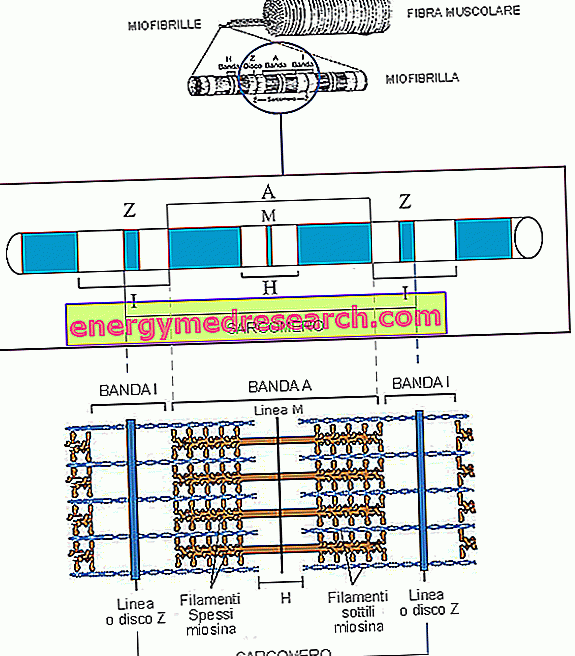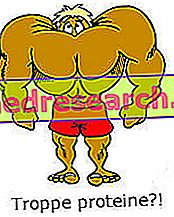By Dr. Dario Mirra
Skeletal muscle: outline of functional anatomy
The muscle is composed of different elements that form its structure. The different functional units of the striated muscle are called sarcomeres or inocommates, real functional units of movement.
To have a clear idea of the way in which the muscle creates movement, and having already the biochemical, physiological and neurological function underlying the muscle contraction, it is necessary to have two clear concepts:
- the constitution of the protein mesh that underlies the functions of the muscle itself;
- the physical relationships that underlie the movement.
1From a simplistic point of view, the proteins that make up the sarcomere can be divided into 3 categories:
- Contractile proteins: Actin and Myosin.
- Regulatory proteins: Troponin and Tropomyosin.
- Structural proteins: Titin, Nebulin, Desmina, Vinculina, etc.
If you then observe a muscular preparation under the microscope you can easily observe the presence of bands of different colors, which correspond to different functional areas.
So from a purely educational point of view considering these areas, we have:
- Discs Z - Delimit the sarcomere. They are the anchor points for proteins, they are the site of injuries during muscular work, they come close to each other during the contraction.
- Band A - Corresponds to the length of the myosin filament.
- Band I - Corresponds to two rows of Actin in two contiguous sarcomeres.
- Band H - Corresponds to the area between two rows of Actin in the same sarcomere.
- Line M - Divide the sarcomere into two symmetrical portions.

Spatial reports of myofilaments in sarcomere. A sarcomere is bounded at its ends by two series Z
2) In the following, instead, the physical relationships that can help to better understand some peculiarities of the human movement are exposed:
a) Relationship Strength-Length
The peak force (L 0 ) depends on the degree of overlap of the contractile proteins. A resting fiber has a length of about 2.5 micrometers, with the sarcomere reaching lengths that can reach about 3.65 micrometers, since the thick filaments have a length of 1.6 micrometers, while the thin ones of 1 micrometer. The peak of force is obtained when the overlap of proteins places itself around 2 - 2.2 micrometers.

a) there is no active force since there is no contact between the myosin heads and actin
Between a) and b): there is a linear increase in the active force due to the increase in the available binding sites of the actin for the myosin heads
Between b) and c): the active force reaches its maximum peak and remains relatively stable; in this phase, in fact, all myosin heads are related to actin
Between c) and d): the active force begins to decrease as the overlapping of the actin chains reduces the binding sites available for the myosin heads
e): once myosin collides with disk Z there is no active force since all myosin heads are attached to actin; furthermore, myosin is compressed on the Z disks and acts as a spring, opposing the contraction with a force proportional to the degree of compression (hence muscle shortening)
b) Force-speed relationship

c) Speed-Length relationship
If the muscular force is proportional to the transverse diameter of the fiber, the speed depends on the number of fibers in series along the course of the fiber itself. So if we assumed a Delta L shortening and we had 1000 sarcomeres in series, the total shortening would be:
1000xDelta L / Delta t
So the longer the muscles, the greater acceleration trajectories will be available.
Speed Report - Hypertrophy
Anyone who has tried their hand at working with weights without doing parallel stretching or stretching has been able to easily notice the feeling of greater rigidity during sports movements or in normal daily gestures. In fact, excessive hypertrophy increases internal viscosity and connective tissue retraction; it is therefore deducible that muscle hypertrophy does not favor explosive-ballistic or speed-related movements, as it is known that friction within the muscle must be minimal to allow optimal flow of contractile proteins. From this relationship it is also possible to deduce the greater eccentric strength of the Bodybuilders, as the exasperated hypertrophy creates strong internal frictions and that act as support in the ceding movements.
Conclusions
Through the explanation of the constitution of the structural mesh and the physical relationships that bind the muscle to the movement, it was my intention with this article to give the reader a major element to understand with a little more clarity that sports gestures, as well as daily ones, go beyond what can be lifting a barbell or just walking; to be better understood in their complexity, these gestures require a knowledge of anatomy, physiology, biochemistry and all complementary subjects, which make it understand how the physical sciences are anything but improvisations on the part of practitioners, and of how they need multiple "knowledge" that embraces theory and practice.



